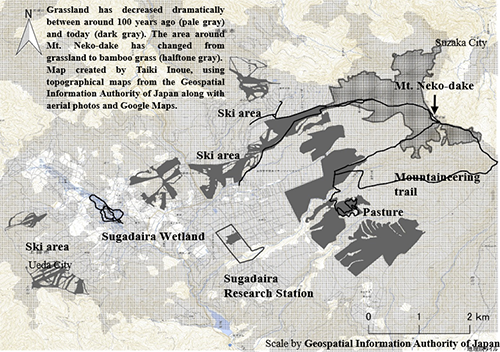EFFORTS OF UNIVERSITY OF TSUKUBAEfforts of University of Tsukuba

Passing down untapped genetic resources: Constructing measures on a regional basis for ecosystem utilization that protect rare plants and host-specific microorganisms

Fig. 1. Ecosystem management region of the Mt. Nekodake and Sugadaira area. Light gray: Pasture. Dark gray: Ski area. Black lines: Mountain trails and footpaths.
60% of new drugs are of biological origin, making it clear that biodiversity is the foundation that sustains our society. Most of the microbial genetic resources, themselves the topic of Satoshi Omura’s Nobel Prize in Physiology or Medicine-winning work, have the potential to be host-specific species that live through a symbiotic and parasitic relationship with a specific plant or organism. But due to slow efforts in understanding these organisms, they may fade into extinction along with their hosts without ever being known. Understanding and preserving these genetic resources are urgent issues, both from the perspective of equity between
societal sustainability and the future generation.
The Sugadaira Plateau boasts a diverse range of highland and alpine plants, many of which are in danger of extinction. The area is employed as a model region in this research to (1) search for and understand unutilized genetic resources through comprehensive microbial detection via next-generation sequencing of 300 types of plants’ roots, leaves and reproductive systems. From there we aim to (2) evaluate pharmaceutical development potential of those microbial genetic resources through culturing them in isolation and conducting a bioassay of the extract. Previous results inform us of the success rate and average market value of pharmaceutical development potential-positive bacteria, enabling us to evaluate the potential economic value of unutilized genetic resources on the Sugadaira Plateau. Additionally, we aim to 3) clarify the effects of rare plant conservation through ecosystem management measures while determining the societal conditions for implementation of those measures in order to construct measures for ecosystem utilization on a regional basis that enable us to pass those unutilized genetic resources down to the next generation.
Reference: Mountain Science Center website:http://www.msc.tsukuba.ac.jp/
Associate Professor, Faculty of Life and Environmental Sciences, University of Tsukuba
TOJU Hirokazu
Assistant Professor, Kyoto University
KUROKAWA Hiroko
Principal Researcher, Forestry and Forest Products Research Institute
NONAKA Kenichi
Assistant Professor, Kitasato University
YOSHIDA Kunimitsu
Associate Professor, Kanazawa University




